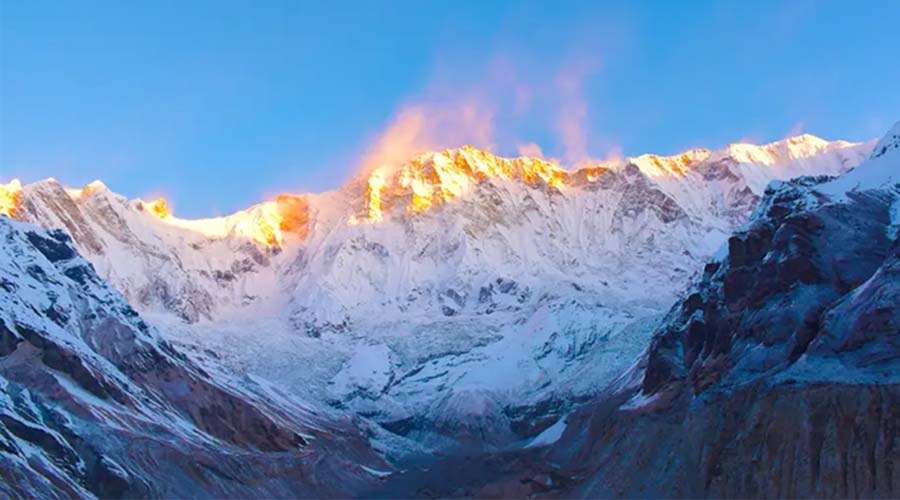The Annapurna Massif is one of the most awe-inspiring mountain ranges in the world, situated in north-central Nepal within the majestic Himalayas. Known for its sheer beauty, spiritual significance, and extreme mountaineering challenges, the massif captures the imagination of travelers, adventurers, and scholars alike. Stretching across roughly 55 kilometers, it comprises several high peaks, deep gorges, and glacial valleys, making it both a geographical wonder and a cultural treasure.
Geographical Overview
At the heart of the massif lies Annapurna I Main, which stands at 8,091 meters (26,545 feet) above sea level. It is the tenth highest mountain on Earth and became historically significant when it was the first 8,000-meter peak ever climbed, in 1950, by Maurice Herzog and Louis Lachenal of a French expedition. Surrounding Annapurna I are a number of other prominent peaks such as Annapurna II (7,937 m), Annapurna III (7,555 m), Annapurna IV (7,525 m), Annapurna South (7,219 m), and Gangapurna (7,455 m). Together, they form a breathtaking crown of summits that dominate the skyline.
The massif also surrounds the Annapurna Sanctuary, a high glacial basin enclosed by towering peaks. The deep Kali Gandaki Gorge, one of the deepest in the world, separates the Annapurna range from the Dhaulagiri massif to the west. These dramatic geographic features contribute to some of the most varied terrain and ecosystems on the planet.
Cultural Significance
The name “Annapurna” has its roots in Sanskrit, meaning “Goddess of the Harvest” or “Provider of Nourishment.” In Hindu tradition, Goddess Annapurna is associated with food, sustenance, and abundance, representing the sustaining power of nature. The massif therefore holds sacred value for local communities, who regard the mountains as divine protectors of the land. Temples, shrines, and rituals dedicated to the goddess are woven into the cultural fabric of the region, reflecting a deep spiritual relationship between the people and the natural landscape.
The surrounding villages are inhabited by diverse ethnic groups, including Gurung, Thakali, and Magar communities, each of which contributes unique traditions, languages, and cuisines. Trekking routes through Annapurna open windows into these rich cultural tapestries, offering travelers encounters with age-old customs and heartfelt hospitality.
Mountaineering History and Challenges
While Annapurna I is famous for being the first eight-thousander summited, it also carries a grim reputation as one of the deadliest mountains for climbers. Its steep south face is among the most difficult ascents in the world, demanding advanced technical skills, resilience, and an ability to withstand some of the harshest mountain weather. Avalanches, icefalls, and unpredictable storms have contributed to a historically high fatality rate compared to other Himalayan giants, making every successful expedition an extraordinary achievement.
Despite the dangers, Annapurna has continued to captivate mountaineers. Renowned climbers such as Reinhold Messner and Jerzy Kukuczka have made notable ascents, further establishing the massif as a crucible for testing human endurance and mountaineering prowess.
The Annapurna Conservation Area
The Annapurna region is also home to the Annapurna Conservation Area (ACA), Nepal’s largest protected area, established in 1986. Spanning about 7,600 square kilometers, it encompasses diverse climates ranging from subtropical forests to alpine meadows and snowfields. This biodiversity hotspot is home to species such as the snow leopard, Himalayan tahr, musk deer, and the colorful Himalayan monal (Nepal’s national bird).
The ACA has pioneered community-based conservation. Local residents participate in managing resources, developing eco-tourism, and protecting fragile ecosystems. Revenues from trekking permits are reinvested in education, healthcare, infrastructure, and conservation initiatives, ensuring that local communities benefit directly from tourism.
Trekking Paradise
The Annapurna Massif attracts thousands of trekkers annually, thanks to its extensive network of trails and accessible yet spectacular terrain. The Annapurna Circuit Trek, once renowned as one of the best long-distance treks in the world, takes adventurers around the massif, crossing the dramatic Thorong La Pass at 5,416 meters.
Another popular route is the Annapurna Base Camp Trek, which brings trekkers into the heart of the sanctuary surrounded by sheer mountain walls. Shorter options, like the Ghorepani-Poon Hill trek, offer panoramic sunrise views over the snow-clad peaks, making them ideal for those with less time or stamina. Unlike the extreme mountaineering routes, these treks are accessible to a wide range of travelers, combining natural splendor with cultural immersion.
Environmental Concerns
While the Annapurna region thrives as a hub of eco-tourism, it also faces challenges. Climate change has accelerated glacial melting and increased the risks of floods and landslides. Growing tourism brings environmental pressures, including waste management and trail erosion. However, awareness and local management efforts have strengthened over the years, aiming to balance tourism growth with sustainable practices.
Conclusion
The Annapurna Massif is far more than a collection of lofty peaks. It is a harmonious blend of natural grandeur, human aspiration, and cultural reverence. From its dangerous yet alluring mountains that test climbers’ limits, to its welcoming villages and sacred traditions, the massif embodies the essence of the Himalayas. As trekkers wind through its valleys, climbers scale its icy walls, and communities safeguard its ecosystems, Annapurna continues to inspire and nourish the body, mind, and spirit—just as its name suggests.


